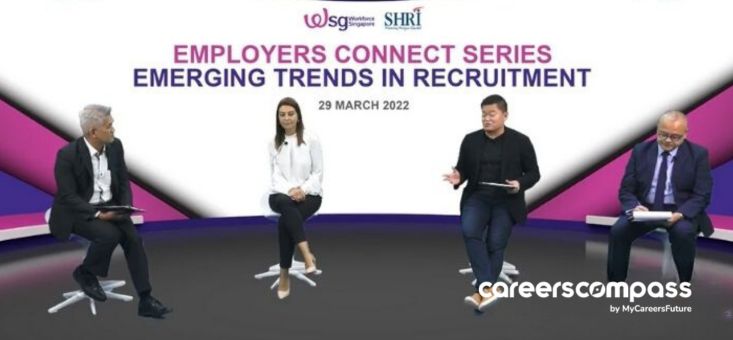Watch a quick video summary of the event here!
In our post-pandemic world, talent acquisition practices and strategies are continually changing. For employers, employees and jobseekers, it’s crucial to catch up on the latest recruitment trends and tactics.
At the same time, internal training and human resource policies have also become important to keep track of. Upskilling and reskilling have moved beyond just being buzzwords, due to the increased digitalisation during Covid-19 for most industries.
If you’re looking to stay in the loop, here are some questions that employers and HR managers asked during Workforce Singapore’s (WSG) latest Employers Connect digital event.
Over 500 attendees registered to listen in to this webinar, brought to you by the Singapore Human Resources Institute (SHRI) and WSG, which included business leaders such as Patrick Kwok (PK), the general manager for Starbucks Coffee Singapore, Goh Jia Yong (JY), a partner in Ernst & Young’s People Advisory Services, as well as Betul Genc (BG), the Adecco Group’s Singapore country manager.
“What does it take to attract and engage younger workers these days?”
PK: I think our workforce is quite young, with an average age of around 34. Engaging with them comes down to both culture and integrating tech for our tech-savvy workers. When you come to a Starbucks you don’t see our tech — it’s all at the backend.
Our technology is designed to help them take orders more efficiently, or automate tasks so that they can focus on connecting with customers. That’s what distinguishes us — our tech is used to buy bandwidth so that our workers can maintain our services’ human touch.
JW: Exactly. It’s the same for us at Ernst & Yong — it’s all about connecting people, from our clients, to our team members and stakeholders.
At the end of the day, why any company approaches us for a consult is because they want a real person to solve their business channel.
This is why hybrid working matters to us. If everyone is working from home, establishing the human ties and connection that makes this genuine and real is difficult.
BG: In addition, for younger workers, it is important to connect the values an organization has with the people they hire.
In addition, showcasing a management style where leaders really hear what employers say, and don’t say, is important. You don’t have to wait for candidates to become candidates. Engage potential employees at schools, and find out what motivates them.
“Data Analytics — is it only for the big boys, or can small and medium enterprises(SMEs) join in?”
JY: If you asked me this question a decade ago, yes, this would have been true. But data has been democratised, with multiple platforms and services available at cost-effective prices. SMEs can tap on that, but of course it’s crucial for them to have the know-how on what to execute, and also which are the best platform tools and services.
Fortunately in Singapore, we do have an ecosystem of SME centres that will advise owners and employers on cost-effective solutions.
PK: My take is to focus on low-hanging fruit first. At Starbucks, yes, we have machine learning and artificial intelligence teams and resources to tap on, but the fundamentals have always been about trying to understand our own customers and the service we provide them first and foremost.
Even without sophisticated tools, just taking the time to look at the data from your own company’s transactions is also a form of data analytics. Take baby steps. For example, each day, just look at a hundred transactions your company made, and put some time and effort to understand how they came about, and the customer’s point of view throughout their sales journey.
“In the current economic climate, how do we convince cost-sensitive management to reskill and upskill workers based on current recruitment trends?”
JY: Well, in my experience as a consultant, most towkays tend to hate missing out on business opportunities. The way to put it across might be to explain that while some strategies do have a cost, what will you be leaving on the table if you don’t make the necessary investments in your workers?
Help them consider the added business opportunities and revenue that can ensue from transforming and improving the skillsets of their employees. When you think about the upside, the downside will manage itself.
“We are looking into digitalisation, but there is resistance. How do we smoothen the transition and assure employees that they won’t be replaced by technology?”
JY: Simplify the tech for the people. As HR managers and business owners, you should know your workforce. Within your own organization, understand what your employee’s current level of digital skills are and move in incremental steps, rather than taking a big leap to take on the biggest and best digital options out there.
Help workers understand that the tech helps them do their work faster and better so that they can focus on things that the tech can’t do!
Take human resource staff for example: tech can’t help them understand their co-workers. The point of advanced systems is to free up their time to have these conversations to be able to meet both employee and employer aspirations and goals.
And here’s one last point that’s food for thought for bosses and towkays: are you prepared to digitalise and learn new technologies yourself?
If you keep saying you’re “old school”, and still ask for faxes instead of emails, or 100% in-person meetings instead of having hybrid meetings… then you’re not role-modelling digitalisation and change for your own workforce, right?















